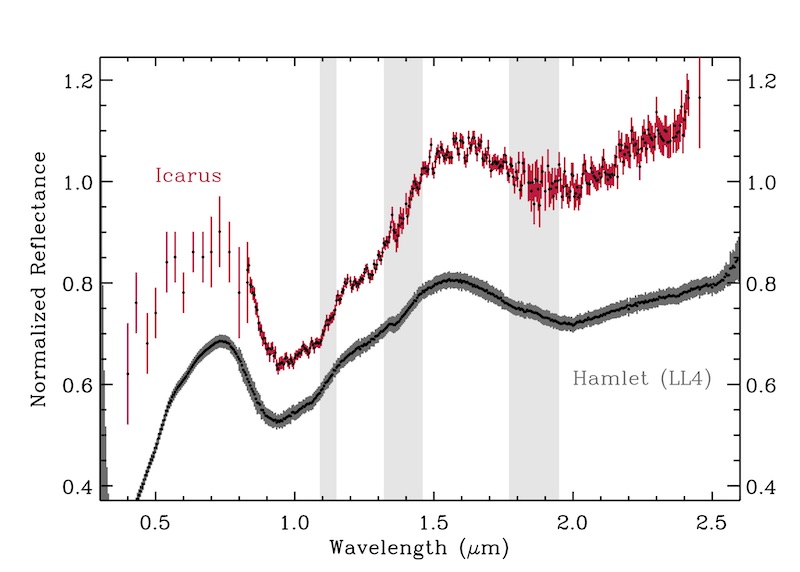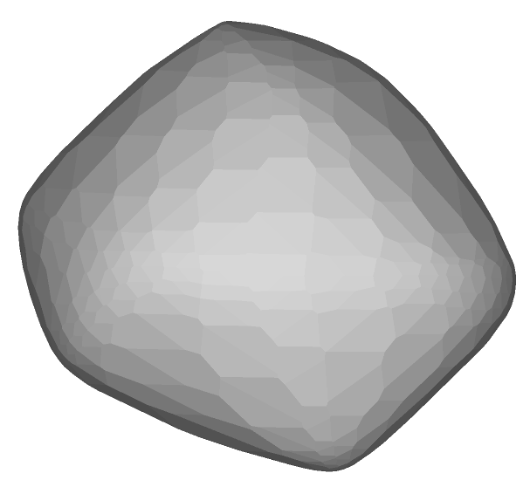Shape, Compositional, and Thermophysical Properties of (1566) Icarus
- 1Department of Physics, University of Helsinki, P.O. Box 64 Gustaf Hällströmin katu 2, FI-00014 Helsinki, Finland
- 2Asteroid Engineering Lab, Space Systems, Luleå University of Technology, Box 848, SE-98128 Kiruna, Sweden
- 3Astronomical Observatory Institute, Faculty of Physics, A. Mickiewicz University, Słoneczna 36, 60-286 Poznań, Poland
- 4Department of Astronomy and Planetary Science, Northern Arizona University, Flagstaff, Arizona, 86011-6010, U.S.A.
The km-scale near-Earth object (1566) Icarus has an extremely eccentric orbit with a perihelion of q = 0.187 au and is classified as a potentially hazardous asteroid (PHA). It has been suspected to be the larger component of an asteroid pair, with the smaller object 2007 MK6, that is dynamically adjacent to the Taurid-Perseid meteor shower (Ohsutka et al., 2007; Kasuga & Jewitt, 2019). The low radar albedo of ~2% and photometric behavior at high phase angles together suggest a high-porosity surface with a high macroscopic roughness (Greenberg, et al. 2017; Ishiguro, et al., 2017). Delay-Doppler and visible lightcurve observations indicate a retrograde spin with a rapid rotation period of ~2.26 hr (Greenberg, et al. 2017; Warner et al., 2009).
Combining visible spectrophotometry from the 24-Color Asteroid Survey (Chapman et al., 2020) and MITHNEOS near-infrared reflectance spectra (Binzel et al., 2019), we classify Icarus (Figure 1) as a slightly space weathered LL chondrite via a band parameter analysis routine (MacLennan, et al. in prep.). Using archived lightcurve observations of Icarus collected in 1968 and 2015 (Lagerkvist et al., 1993; Warner et al., 2009), and informed by spin axis constraints, we implement a Bayesian lightcurve inversion approach (Muinonen, et al. 2020) to construct a convex shape model of Icarus (Figure 2).

Figure 1. Combined visible spectrophotometry and near-infrared reflectance spectra of Icarus and reflectance spectrum of the LL4 ordinary chondrite Hamlet from the RELAB database.

Figure 2. Convex shape model of Icarus from inversion of lightcurve photometry.
We incorporate thermal infrared data from the Spitzer Space Telescope (IRAC photometry and IRS spectra) and the NEOWISE survey in order to characterize Icarus’s thermophysical properties. We estimate the effective diameter and thermal inertia to be 1.4 ± 0.2 km and 60 ± 40 J K-1 m-2 s-1/2, respectively, with moderate surface roughness. The relatively low thermal inertia is consistent with a high porosity surface and/or a fine-grained lunar like surface. The latter interpretation is in contradiction to the polarization-phase relationship that suggests larger regolith grains (Ishiguro et al., 2007). We attempt to reconcile these different measurement results in our presentation.
The physical characteristics of this extreme object are important for informing various resurfacing processes that have been proposed to be relevant for rapidly rotating objects, near-Sun asteroids, and spectrally-fresh Q-type asteroids (Graves et al., 2018, 2019). We thus consider our results in the context of these resurfacing processes.
References:
Binzel, R.P., et al. (2019) “Compositional distributions and evolutionary processes for the near-Earth object population: Results from the MIT-Hawaii Near-Earth Object Spectroscopic Survey (MITHNEOS)” Icarus, 324, 41–76.
Chapman, C.R., Gaffey, M., and McFadden, L. (2020) 24-color Asteroid Survey V1.0. urn:nasa:pds:gbo.ast.24-color-survey::1.0. NASA Planetary Data System.
Greenberg, A., et al. (2017) “Asteroid 1566 Icarus’s Size, Shape, Orbit, and Yarkovsky Drift from Radar Observations” AJ, 153:108.
Graves, et al. (2018) “Resurfacing asteroids from YORP spin-up and failure”, Icarus, 304 (2018) 162–171.
Graves, et al. (2019) “Resurfacing asteroids from thermally induced surface degradation”, Icarus, 322 (2019) 1–12.
Ishiguro, M., et al. (2017) “Polarimetric Study of Near-Earth Asteroid (1566) Icarus”, AJ, 154:180.
Kasuga, T. & Jewitt, D. (2019) “Asteroid-Meteorite Complexes”, In Meteoroids: Sources of Meteors on Earth and Beyond (Ed. G. Ryabova, D. Asher, & M. Campbell-Brown).
Lagerkvist, C.-I. and Magnusson, P., Eds., (2011) Asteroid Photometric Catalog V1.1. EAR-A-3-DDR-APC-LIGHTCURVE-V1.1. NASA Planetary Data System.
MacLennan, E.M., et al. (in prep) “Empirical characterization of space weathering on ordinary chondrite-like asteroids”.
Muinonen , J. Torppa , X.-B. Wang , A. Cellino , and A. Penttilä (2020) “Asteroid lightcurve inversion with Bayesian inference”, A&A, 642, A138.
Ohtsuka, K. “Apollo asteroids 1566 Icarus and 2007 MK6: Icarus Family Members?” AJ, 668: L71–L74.
Warner, B.D., Harris, A.W., Pravec, P. (2009). “The Asteroid Lightcurve Database”, Icarus 202, 134-146.
How to cite: MacLennan, E., Muinonen, K., Uvarova, E., Granvik, M., Wilawer, E., Oszkiewicz, D., and Emery, J.: Shape, Compositional, and Thermophysical Properties of (1566) Icarus, Europlanet Science Congress 2022, Granada, Spain, 18–23 Sep 2022, EPSC2022-893, https://doi.org/10.5194/epsc2022-893, 2022.

